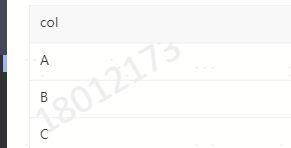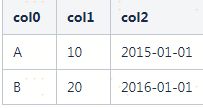Hive内嵌表生成函数UDTF:explode,posexplode,json_tuple,parse_url_tuple,stack
0.Hive内嵌表生成函数
Built-in Table-Generating Functions (UDTF)
普通的用户定义函数,如concat(),接受单个输入行并输出单个输出行。相反,表生成函数将单个输入行转换为多个输出行
| Row-set columns types |
Name(Signature) |
Description |
|---|---|---|
| T |
explode(ARRAY |
Explodes an array to multiple rows. Returns a row-set with a single column (col), one row for each element from the array. 将数组分解为多行。返回一个单列(col)的行集,数组中的每个元素对应一行。 |
| Tkey,Tvalue |
explode(MAP |
Explodes a map to multiple rows. Returns a row-set with a two columns (key,value) , one row for each key-value pair from the input map. (As of Hive 0.8.0.). |
| int,T | posexplode(ARRAY |
Explodes an array to multiple rows with additional positional column of int type (position of items in the original array, starting with 0). Returns a row-set with two columns (pos,val), one row for each element from the array. 将数组分解为多行,其中包含int类型的附加位置列(原始数组中的位置,从0开始),意思行转列以后,还多一列数组元素对应下标的列。 |
| T1,...,Tn |
inline(ARRAY |
Explodes an array of structs to multiple rows. Returns a row-set with N columns (N = number of top level elements in the struct), one row per struct from the array. (As of Hive 0.10.) 将一个结构数组分解为多行。返回一个包含N列的行集(N =结构中顶级元素的数量),数组中的每个结构中有一行。 |
| T1,...,Tn/r | stack(int r,T1 V1,...,Tn/r Vn) | Breaks up n values V1,...,Vn into r rows. Each row will have n/r columns. r must be constant. 分解n值V1,…,将Vn分成r行。每一行都有n/r列。r必须是常数。 |
| string1,...,stringn |
json_tuple(string jsonStr,string k1,...,string kn) |
Takes JSON string and a set of n keys, and returns a tuple of n values. This is a more efficient version of the |
| string 1,...,stringn |
parse_url_tuple(string urlStr,string p1,...,string pn) |
Takes URL string and a set of n URL parts, and returns a tuple of n values. This is similar to the |
1.案例演示
1.1 explode,一般和lateral view explode一起使用
一般用来实现表的行转列
select explode(array('A','B','C'));
select explode(array('A','B','C')) as col;
select tf.* from (select 0) t lateral view explode(array('A','B','C')) tf;
select tf.* from (select 0) t lateral view explode(array('A','B','C')) tf as col;select explode(map('A',10,'B',20,'C',30));
select explode(map('A',10,'B',20,'C',30)) as (key,value);
select tf.* from (select 0) t lateral view explode(map('A',10,'B',20,'C',30)) tf;
select tf.* from (select 0) t lateral view explode(map('A',10,'B',20,'C',30)) tf as key,value;1.2. posexplode的使用
select posexplode(array('A','B','C'));
select posexplode(array('A','B','C')) as (pos,val);
select tf.* from (select 0) t lateral view posexplode(array('A','B','C')) tf;
select tf.* from (select 0) t lateral view posexplode(array('A','B','C')) tf as pos,val;1.3 inline的使用
select inline(array(struct('A',10,date '2015-01-01'),struct('B',20,date '2016-02-02')));
select inline(array(struct('A',10,date '2015-01-01'),struct('B',20,date '2016-02-02'))) as (col1,col2,col3);
select tf.* from (select 0) t lateral view inline(array(struct('A',10,date '2015-01-01'),struct('B',20,date '2016-02-02'))) tf;
select tf.* from (select 0) t lateral view inline(array(struct('A',10,date '2015-01-01'),struct('B',20,date '2016-02-02'))) tf as col1,col2,col3;
1.4 stack的使用
select stack(2,'A',10,date '2015-01-01','B',20,date '2016-01-01');
select stack(2,'A',10,date '2015-01-01','B',20,date '2016-01-01') as (col0,col1,col2);
select tf.* from (select 0) t lateral view stack(2,'A',10,date '2015-01-01','B',20,date '2016-01-01') tf;
select tf.* from (select 0) t lateral view stack(2,'A',10,date '2015-01-01','B',20,date '2016-01-01') tf as col0,col1,col2;
1.5 json_turple 的使用
在Hive 0.7中引入了一个新的json_tuple() ,是UDTF。它的参数是一个JSON字符串和一组key键,并使用一个函数返回一个元组值。这比调用GET_JSON_OBJECT从一个JSON字符串中检索多个键要高效得多。相当于加强版的get_JSON_OBJECT。它可以一次返回多个object,以元组的形式存储。
select a.timestamp, b.*
from log a lateral view json_tuple(a.appevent, 'eventid', 'eventname') b as f1, f2;1.6 parse_url_tuple的使用
parse_url_tuple() 是UDTF函数,类似于UDF中的parse_url(),但是可以同时提取给定URL的多个部分,以元组的形式返回数据。例如parse_url_tuple('http://facebook.com/path1/p.php?(k1=v1&k2=v2#Ref1', 'QUERY:k1', 'QUERY:k2')返回一个值为'v1','v2'的元组。这比多次调用parse_url()更有效。所有输入参数和输出列类型都是string。





